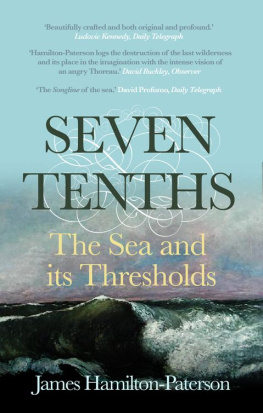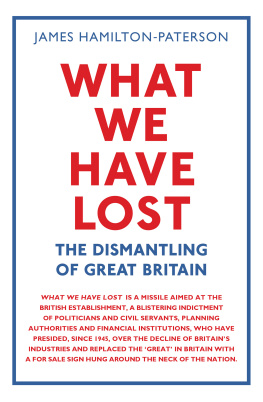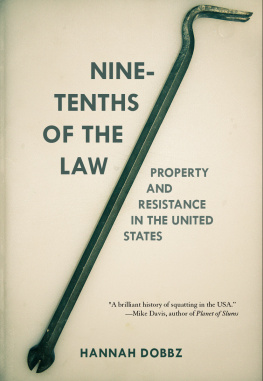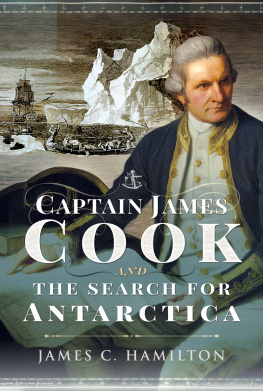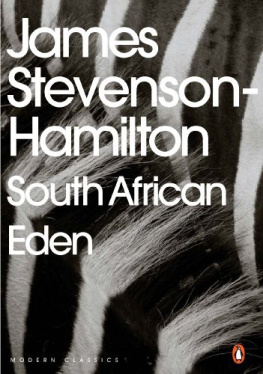James Hamilton-Paterson - Seven-Tenths. The Sea and its Thresholds
Here you can read online James Hamilton-Paterson - Seven-Tenths. The Sea and its Thresholds full text of the book (entire story) in english for free. Download pdf and epub, get meaning, cover and reviews about this ebook. year: 2011, publisher: Faber and Faber Ltd;Faber & Faber;Faber & Faber Non Fiction, genre: Art. Description of the work, (preface) as well as reviews are available. Best literature library LitArk.com created for fans of good reading and offers a wide selection of genres:
Romance novel
Science fiction
Adventure
Detective
Science
History
Home and family
Prose
Art
Politics
Computer
Non-fiction
Religion
Business
Children
Humor
Choose a favorite category and find really read worthwhile books. Enjoy immersion in the world of imagination, feel the emotions of the characters or learn something new for yourself, make an fascinating discovery.
- Book:Seven-Tenths. The Sea and its Thresholds
- Author:
- Publisher:Faber and Faber Ltd;Faber & Faber;Faber & Faber Non Fiction
- Genre:
- Year:2011
- Rating:5 / 5
- Favourites:Add to favourites
- Your mark:
- 100
- 1
- 2
- 3
- 4
- 5
Seven-Tenths. The Sea and its Thresholds: summary, description and annotation
We offer to read an annotation, description, summary or preface (depends on what the author of the book "Seven-Tenths. The Sea and its Thresholds" wrote himself). If you haven't found the necessary information about the book — write in the comments, we will try to find it.
Seven-Tenths. The Sea and its Thresholds — read online for free the complete book (whole text) full work
Below is the text of the book, divided by pages. System saving the place of the last page read, allows you to conveniently read the book "Seven-Tenths. The Sea and its Thresholds" online for free, without having to search again every time where you left off. Put a bookmark, and you can go to the page where you finished reading at any time.
Font size:
Interval:
Bookmark:
For my Mother
Also
to the memory of
Ben Chong and Arnel Julao,
last seen on 20 December 1987
hoping to stow away aboard M/V Doa Paz
in order to join their families
for Christmas
Re-reading this book was both reassuring and sobering. It was reassuring to an author that so little needed to be changed after fifteen years, and sobering for the same reason. In that time marine science has moved on and fascinating new data have emerged; but nothing, I think, to alter radically my original standpoint. On the political front, one signal and welcome development has been the ban by both the UN and the EU on drift-net fishing. Nevertheless, the steely attrition of the worlds oceans proceeds at an ever-accelerating pace. Given the examples of well-monitored commercial stocks collapsing from over-fishing, the devastation currently being wrought by fishing fleets around the world is a spectacle that makes one wonder afresh at the hubris in styling ourselves Homo sapiens.Homo stultus would have been more accurate taxonomy.
In the long run, of course, our present cavalier treatment of the oceans matters not a jot. However heedless our self-interest, the sea will survive. It will outlive us and remain the source and origin of the planets biota aeons from now. In any case, in writing this book I had no interest in producing an environmentalist jeremiad. On the contrary, I wanted to convey something of the affection, awe and often loathing that people have always felt for this mysterious body of water, both our cradle and the earths largest geophysical feature. The sea leaks unconsciously into even the most land-lubberly of us from time to time, and manages to leave its tide marks in cultures as in rocks the world over.
The few minor changes I have made to the original text for this new edition are nearly all updatings, and those mainly to the chapter on fishing. I have also added some footnotes to take account of things like new free-diving records or oceanographical data. The single new addition is the inclusion of Sea Burial, originally published in Granta, which describes a sea voyage I once made in the tropics. Neither precisely reportage nor fiction, it was an attempt to express that strange borderland where the seas power to haunt sometimes seems as real a force as a waves kinetic energy.
James Hamilton-Paterson
2006
I gratefully acknowledge the help given me in the writing of this book by the following:
Anna Badini, Anabel Briggs, Paul Brown, Peter Chaplin, Mario and Roberta DItria, Frank Donn, Earthtrust (Hawaii), the scientists and crew of the R/V Farnella, Stephan Feuchtwang, Bill Foster, Luis Go, Abdurrahim Hasim, Ellis Hillman, Frank Sionil Jos, Abdurahim Kenoh, Cdr Reuben S. Lista (Philippine Navy), George May, James May, John May, Anita McConnell, Gilbert Tait, Saladin S. Teo, Marcello Vanni, Ian West.
I would like to thank the Institute of Oceanographic Sciences, Deacon Laboratory, and especially Mike Somers and Tony Rice for their courtesy and help. Above all, Quentin Huggett has been unfailingly patient and generous with his time, a prodigality which it is a pleasure to acknowledge.
My agents deserve and get my very warmest thanks for their tireless support and help, as does Patricia Reynolds.
This books commissioning editor was Richard Cohen, and I am conscious that it owes everything to his original encouragement. To that extent it remains his. The task of taking it on fell to Neil Belton, my present editor. I could not have wished for a more sympathetic and astute interpreter of a project whose intentions must initially have appeared idiosyncratic and opaque.
Finally, my gratitude to Mark Cousins is not easily expressed. One hardly thanks a friend for friendship, but one might well wish to put on record the affectionate recognition of a great debt. The entire book was written very far from his scrutiny, but scarcely a line without awareness of his presence. Private congruences apart, there was for me an especial punctuality about his public lectures at the Architectural Association in London, 19901, which had a profound effect on this book, just as the lectures had on all who heard them.
The above persons are exonerated from all responsibility for any errors of fact, judgement and taste, which are entirely my own.
- from Zetetic Astronomy (1873) 2nd edition.
British Library, London - Private Collection
- (i) & (ii) from The Structure and Distribution of Coral Reefs by Charles Darwin, (1880)
(iii) & (iv) from Corals and Coral Islands by James Dana, London (1872) - from The Christian Miscellany (1860)
Mary Evans Picture Library - from Twenty Thousand Leagues under the Sea by Jules Verne, (1870)
Mary Evans Picture Library - Miraculous Draught of Fishes by Gustav Dor
Mary Evans Picture Library - from Concise Oxford Atlas (1952)
Oxford University Press
I am lost These are the words the swimmer addresses in panic to the sunny universe into which he emerges, blowing water, disoriented. Ten minutes ago, perhaps twenty, he had set some fishing lines and slipped over the side of his tiny craft a wooden insect with two bamboo outriggers with a cord tying its prow to his ankle. He had been lying face down in the ocean, sun on his back, staring through the first thirty of a thousand metres of water. In the tropics these upper waters are flooded with light. Bright spicules drift past his eyes, crimson and electric blue, the jewelled phytoplankton streaming about the globe performing infinitesimal acts of chemistry which, much multiplied, succour all earthly life. By swimming down a couple of dozen feet he can look up and view other creatures from below: a shoal of garfish (whose bones are bright green) so high up their backs graze the rumpled mirror of air, the occasional flying fish breaking out and vanishing. The swimmer reflects on this mirror, imagining the sky weighing down on the sea and the sea holding up the atmosphere, curious about what exactly can be happening at the interface. If it were possible to magnify the activity, surely a buzzing skin of molecules would be revealed? Water molecules and air molecules so intermixed and saturated with atoms in common it would be undecidable which medium they constituted. At what point did these milling particles become waves? The swimmer loses himself in this quantum pun, in his speculations about boundaries, then suddenly an awareness breaks in that something is missing. There is a steady tug at his ankle, but too light. The long cord trails downwards, still firmly knotted to one foot. It is the boat which has gone.
His first act of panic is to spin in the water while trying to stand up in it: once, twice, three times, quartering a featureless horizon. Nothing. He is anchored by twenty feet of thin abaca hemp to the ocean. His masked face rams back through the surface as if by a miracle ofmisplacement he might discover the boat floating at ease in a fourth dimension some fathoms below. Nothing. The cord hangs down like the corals called sea whips, slightly kinked, whiskers of fibre standing out clear in this awesome lens right to the bobble of the knot in its end. The word this knot transmits through the water is adrift.
The swimmer jerks his head up into the air again. Everything is plain. It is not possible, yet the boat has gone. I am lost. Panicked, he pants and spins, boatless, landless, and with the visceral ache of pure fear at what he has abruptly become: all alone and floating in the Pacific Ocean. Reason attempts to be reasonable. How far away could a boat possibly drift on a windless day? Also, eye level is barely six inches above sea level; a boat whose freeboard is little more than three times that could easily be hidden by the least swell. It is no doubt bobbing in and out of visibility even as he happens to scan the wrong horizon. In any case, something altogether calmer is taking over: a lassitude, a fatalism whose roots reach back not to the beginning of his own life but, like the rope on his ankle, down into the sea itself. The twisted fibres, like ancient strands of DNA, connect him with vanished deeps, to primordial oceans lying in different beds. If he is lost now it is because he was already lost before ever setting foot in a boat, before infancy itself. He has no proper existence at all, being only a tiny hole in the water shaped like the lower two-thirds of a man. There is no way the tons of ocean can be held apart and prevented from filling the mould.
Font size:
Interval:
Bookmark:
Similar books «Seven-Tenths. The Sea and its Thresholds»
Look at similar books to Seven-Tenths. The Sea and its Thresholds. We have selected literature similar in name and meaning in the hope of providing readers with more options to find new, interesting, not yet read works.
Discussion, reviews of the book Seven-Tenths. The Sea and its Thresholds and just readers' own opinions. Leave your comments, write what you think about the work, its meaning or the main characters. Specify what exactly you liked and what you didn't like, and why you think so.

